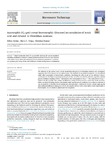Mostrar o rexistro simple do ítem
Autotrophic (C₁-Gas) Versus Heterotrophic (Fructose) Accumulation of Acetic Acid and Ethanol in Clostridium Aceticum
| dc.contributor.author | Arslan, Kübra | |
| dc.contributor.author | Veiga, María Carmen | |
| dc.contributor.author | Kennes, Christian | |
| dc.date.accessioned | 2021-09-20T13:12:04Z | |
| dc.date.available | 2021-09-20T13:12:04Z | |
| dc.date.issued | 2021-07-03 | |
| dc.identifier.citation | Arslan, K., Veiga, M.C., Kennes, C., 2021. Autotrophic (C₁-Gas) versus heterotrophic (fructose) accumulation of acetic acid and ethanol in Clostridium aceticum. Bioresour. Technol. 337, 125485. doi:10.1016/j.biortech.2021.125485 | es_ES |
| dc.identifier.issn | 0960-8524 | |
| dc.identifier.uri | http://hdl.handle.net/2183/28486 | |
| dc.description | Financiado para publicación en acceso aberto: Universidade da Coruña/CISUG | |
| dc.description.abstract | [Abstract] The influence of the carbon source on the metabolism and growth of Clostridium aceticum was investigated, supplying either CO or fructose as sole carbon source. The acid and solvent production patterns were determined under either autotrophic or heterotrophic conditions, elucidating the effect of pH on the substrate's bioconversion pattern. The highest maximum specific growth rate was observed with CO, under the organism's optimal growth conditions, reaching 0.052 h⁻¹ and an acetic acid concentration of 18 g·L⁻¹. The production of 4.4 g·L⁻¹ ethanol was also possible, after medium acidification, during CO bioconversion. Conversely, formic acid inhibition was observed during fructose fermentation under optimal growth conditions. In the latter experiments, it was not possible to stimulate solvent production when growing C. aceticum on fructose, despite applying the same medium acidification strategy as with CO, showing the selective effect of the carbon source (autotrophic vs heterotrophic) on the metabolic pattern and solventogenesis. | es_ES |
| dc.description.sponsorship | This research was funded by the Spanish Ministry of Economy, Industry and Competitiveness (MINECO) through project CTQ2017-88292-R and European FEDER funds, and through European ERA-IB7 project OBAC and PCIN2016-148. The authors, belonging to the BIOENGIN group, thank Xunta de Galicia for financial support to Competitive Reference Research Groups (ED431C 2017/66) | es_ES |
| dc.description.sponsorship | Xunta de Galicia; ED431C 2017/66 | es_ES |
| dc.language.iso | eng | es_ES |
| dc.publisher | Elsevier | es_ES |
| dc.relation | info:eu-repo/grantAgreement/AEI/Plan Estatal de Investigación Científica y Técnica y de Innovación 2017-2020/CTQ2017-88292-R/ES/VALORIZACION DE RESIDUOS PARA LA PRODUCCION DE ALCOHOLES, ACIDOS ORGANICOS Y BIOPOLIMEROS | |
| dc.relation | info:eu-repo/grantAgreement/AEI/Plan Estatal de Investigación Científica y Técnica y de Innovación 2013-2016/PCIN-2016-148/ES/OBAC/ | |
| dc.relation.uri | https://doi.org/10.1016/j.biortech.2021.125485 | es_ES |
| dc.rights | Atribución-NoComercial-SinDerivadas 4.0 Iinternacional | es_ES |
| dc.rights.uri | http://creativecommons.org/licenses/by-nc-nd/4.0/ | * |
| dc.subject | Carbon monoxide | es_ES |
| dc.subject | Carbon dioxide | es_ES |
| dc.subject | Solventogenesis | es_ES |
| dc.subject | Syngas | es_ES |
| dc.subject | Wood-Ljungdahl pathway | es_ES |
| dc.title | Autotrophic (C₁-Gas) Versus Heterotrophic (Fructose) Accumulation of Acetic Acid and Ethanol in Clostridium Aceticum | es_ES |
| dc.type | info:eu-repo/semantics/article | es_ES |
| dc.rights.access | info:eu-repo/semantics/openAccess | es_ES |
| UDC.journalTitle | Bioresource Technology | es_ES |
| UDC.volume | 337 | es_ES |
| UDC.startPage | 125485 | es_ES |
Ficheiros no ítem
Este ítem aparece na(s) seguinte(s) colección(s)
-
GI-BIOENGIN- Artigos [91]






